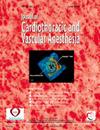比伐鲁定与肝素抗凝治疗ECPella患者血栓形成的比较分析。
IF 2.3
4区 医学
Q2 ANESTHESIOLOGY
Journal of cardiothoracic and vascular anesthesia
Pub Date : 2025-03-31
DOI:10.1053/j.jvca.2025.03.041
引用次数: 0
摘要
目的:回顾和比较肝素或比伐鲁定在静脉-动脉-体外膜氧合(VA-ECMO)和Impella支持(ECPella)支持下接受全身抗凝治疗的患者血栓和不良事件的频率。设计:回顾性观察性研究环境:单一三级学术医疗中心参与者:2021年7月至2024年4月期间接受ECPella支持的年龄为bb0 - 18岁的患者。测量和主要结果:研究人群包括98例患者,其中29例患者接受肝素治疗,35例患者接受比伐鲁定治疗,34例患者接受肝素和比伐鲁定联合治疗。13例患者有主动脉血栓,23例患者有深静脉血栓形成(DVT),抗凝策略无差异。多因素回归表明,年龄和性别是血栓发生风险增加的因素。单独接受肝素治疗的29例患者中有25例死亡,而接受比伐鲁定治疗的35例患者中有15例死亡。3个抗凝组重症监护病房住院时间(LOS)(13.89天vs 24.77天vs 26.65天)无显著差异。有主动脉血栓形成或深静脉血栓形成的患者与没有这两种疾病的患者相比有更长的住院LOS(45.09天vs 28.12天;P = 0.049)。结论:尽管进行了抗凝治疗,但依靠ECPella支撑的患者主动脉血栓的发生率仍然很高。鼓励常规影像学筛查,在脱管时应考虑栓塞切除以减少术后并发症。本文章由计算机程序翻译,如有差异,请以英文原文为准。
Comparative Analysis of Thrombosis in ECPella Patients Between Bivalirudin versus Heparin Anticoagulation Strategies
Objective
To review and compare the frequency of thrombus and adverse events in patients treated with heparin or bivalirudin systemic anticoagulation strategies supported on combined venoarterial extracorporeal membrane oxygenation (VA-ECMO) and Impella support (ECPella)
Design
Retrospective observational study
Setting
Single tertiary academic medical center
Participants
Patients age >18 years who were supported by ECPella between July 2021 and April 2024
Interventions
None
Measurements and Main Results
The study population comprised 98 patients, including 29 patients treated with heparin, 35 patients treated with bivalirudin, and 34 patients treated with a combination of heparin and bivalirudin. Thirteen patients had aortic thrombus and 23 patients had deep vein thrombosis (DVT), with no difference between anticoagulation strategies. Multivariate regression suggested that age and sex were factors in the increased risk for thrombus. Twenty-five of the 29 patients treated with heparin alone died, compared to 15 of the 35 patients treated with bivalirudin. There were no significant differences in intensive care unit length of stay (LOS) (13.89 days vs 24.77 days vs 26.65 days) across the 3 anticoagulation groups. Patients with either aortic thrombosis or DVT had a longer hospital LOS compared to those without either disorder (45.09 days vs 28.12 days; p = 0.049).
Conclusions
The frequency of aortic thrombus in patients supported on ECPella is high despite therapeutic anticoagulation. Routine screening with imaging is encouraged, and embolectomy should be considered at the time of decannulation to reduce postoperative complications.
求助全文
通过发布文献求助,成功后即可免费获取论文全文。
去求助
来源期刊
CiteScore
4.80
自引率
17.90%
发文量
606
审稿时长
37 days
期刊介绍:
The Journal of Cardiothoracic and Vascular Anesthesia is primarily aimed at anesthesiologists who deal with patients undergoing cardiac, thoracic or vascular surgical procedures. JCVA features a multidisciplinary approach, with contributions from cardiac, vascular and thoracic surgeons, cardiologists, and other related specialists. Emphasis is placed on rapid publication of clinically relevant material.

 求助内容:
求助内容: 应助结果提醒方式:
应助结果提醒方式:


